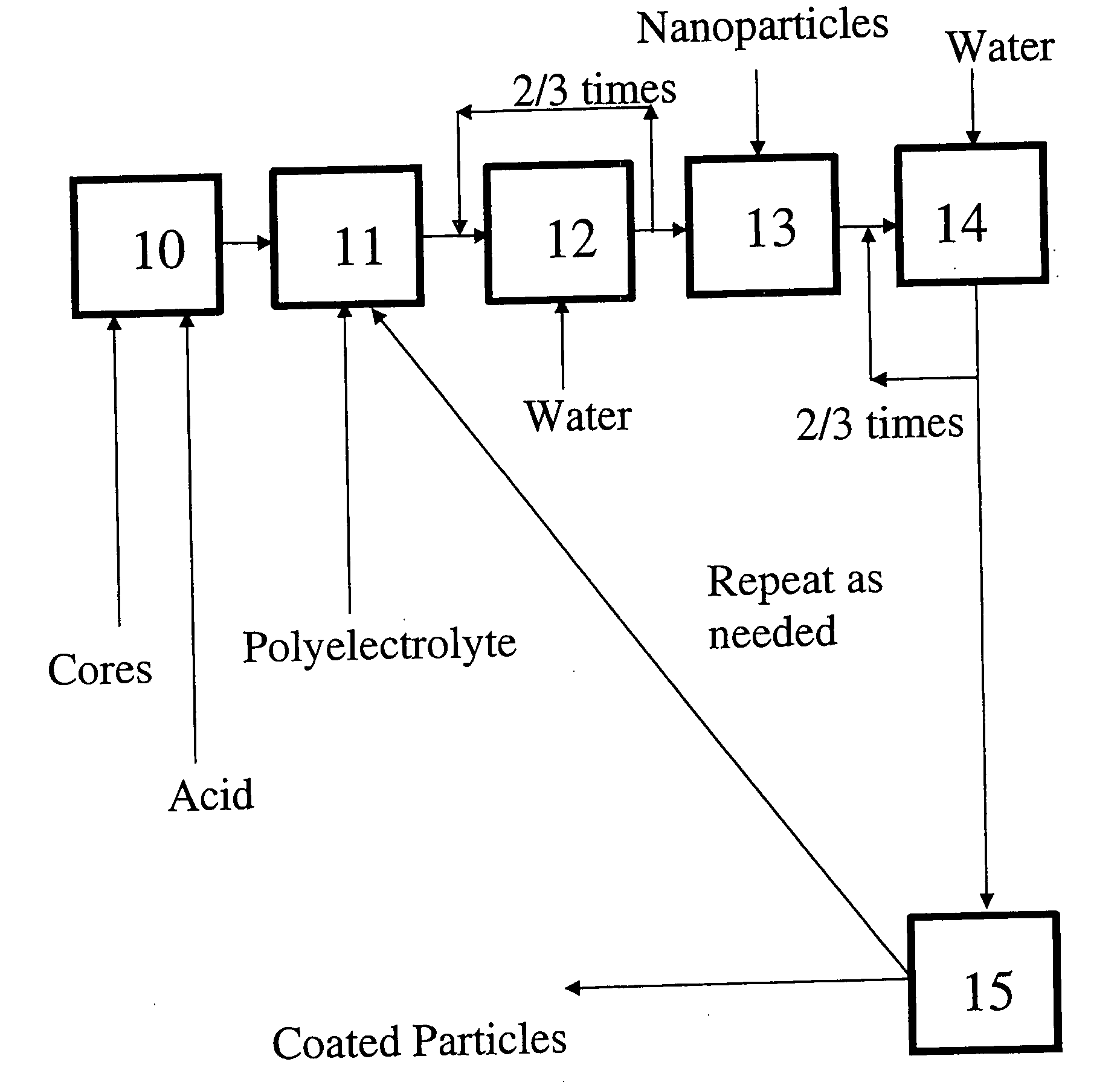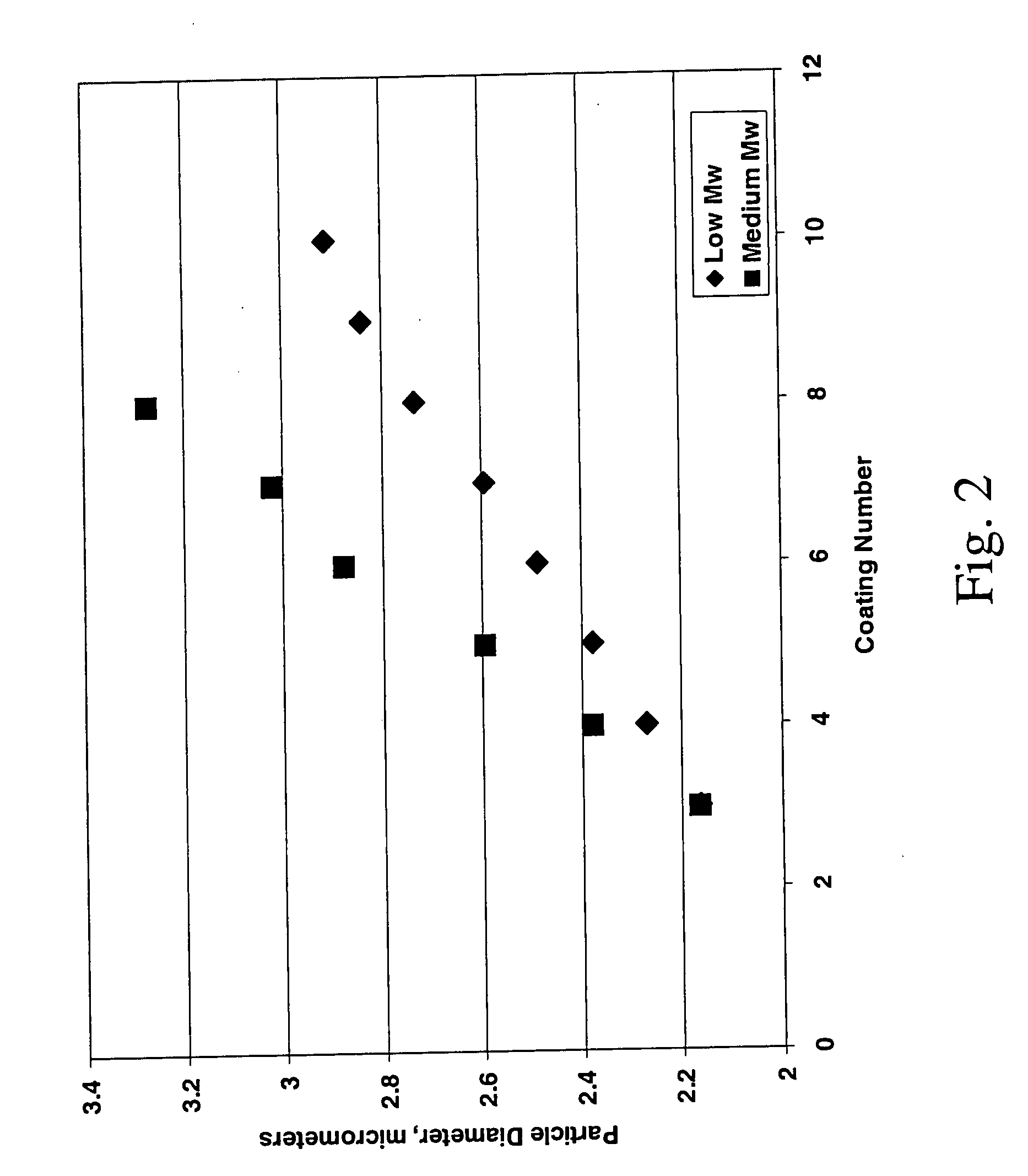Process for preparing substrates with porous surface
a technology of porous surface and nanoparticles, applied in chemical/physical processes, natural mineral layered products, synthetic resin layered products, etc., can solve the problem of repeated interactions, non-uniform disoriented particle mechanical coating, and inability to control variables such as thickness and uniformity of coating
- Summary
- Abstract
- Description
- Claims
- Application Information
AI Technical Summary
Benefits of technology
Problems solved by technology
Method used
Image
Examples
example 1
[0103]A 10% by weight aqueous suspension of silica core particles comprising 5 g of SiO2 particles of diameter 2.0 μm was brought to a pH of 2.3 with nitric acid. To these cores was added 200 grams of 0.5% by weight of aqueous solution of poly(diallyldimethylammonium) chloride (PDADMA). This solution was made by diluting 20% by weight aqueous solutions of polyelectrolyte (Sigma-Aldrich, 409014, 409022, and 409030—“Low”, “Medium”, and “High” weight average molecular weights of PDADMA were used, corresponding to M, values of 100-200 kD, 200-350 kD, and 400-500 kD according to the manufacturer). The polyelectrolyte and silica core suspension was centrifuged at 2,000 rpms for 10 minutes (using a Sorvall T6000 model centrifuge) and the supernatant was decanted. The cores were resuspended in deionized water, centrifuged (about 2,000 rpms for 10 minutes) and the supernatant was decanted. This wash with deionized water was repeated one additional time. 50 grams of an aqueous suspension of s...
example 2
[0105]A 10% by weight aqueous suspension of silica core particles including 5 g of SiO2 of diameter 2.0 μm was brought to a pH of 2.3 with nitric acid. To these cores was added 200 grams of 0.5% by weight of aqueous solution of poly(diallyldimethylammonium) chloride (PDADMA). This solution was made by diluting 20% by weight aqueous solutions of polyelectrolyte (Sigma-Aldrich, 409014 and 409022—“Low” and “Medium” weight average molecular weights of PDADMA were used, corresponding to Mw values of 100-200 kD and 200-350 kD according to the manufacturer.) The polyelectrolyte and silica core suspension was centrifuged at 2,000 rpms for 10 minutes and the supernatant was decanted. The cores were resuspended in deionized water, centrifuged (about 2,000 rpms for 10 minutes) and the supernatant was decanted. This wash with deionized water was repeated two additional times. 15 grams of an aqueous suspension of silica nanoparticles (7.62% SiO2 by weight) of diameter 8 nanometers (nm), adjusted...
PUM
| Property | Measurement | Unit |
|---|---|---|
| ionic strength | aaaaa | aaaaa |
| ionic strength | aaaaa | aaaaa |
| particle size | aaaaa | aaaaa |
Abstract
Description
Claims
Application Information
 Login to View More
Login to View More - R&D
- Intellectual Property
- Life Sciences
- Materials
- Tech Scout
- Unparalleled Data Quality
- Higher Quality Content
- 60% Fewer Hallucinations
Browse by: Latest US Patents, China's latest patents, Technical Efficacy Thesaurus, Application Domain, Technology Topic, Popular Technical Reports.
© 2025 PatSnap. All rights reserved.Legal|Privacy policy|Modern Slavery Act Transparency Statement|Sitemap|About US| Contact US: help@patsnap.com



